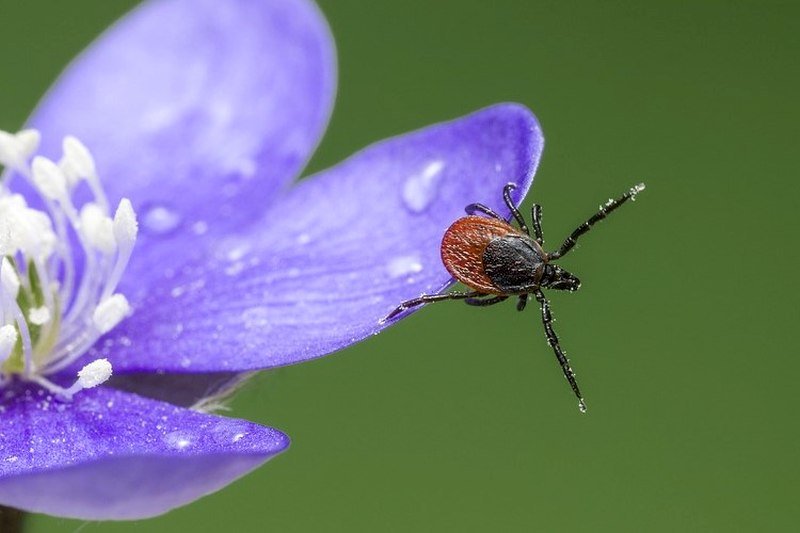Ticks are commonly found all over the world where there are suitable host species. The occurrence of the different species depends on the availability of their respective hosts and on environmental factors such as temperature and air humidity. Most tick species have one or more preferred hosts but can also suck blood from other hosts if necessary.
Where Are Ticks Commonly Found
Ticks do not drop down from trees onto their victims, but sit on plants close to the ground and wait for a suitable host. This behavior when ticks lay in wait on low-growing plants and wait for a host is called “questing”. When a host passes near enough, the ticks will be stripped away from its waiting position unnoticed.
The typical habitat where ticks are commonly found is on the ground or near the ground in the low vegetation. They sit in tall grass, loose leaves, scrub, bushes, undergrowth, or thicket waiting for a victim.
In particular, shady forests, clearings, and undergrowth in deciduous and mixed forests with lush grasses, shrubs, hedges, and bushes as well as hedges near water and wetlands are tick’s preferred habitat.
However, places where are ticks commonly found, are not only the forests and the countryside, but also in city parks, around our houses, and in our gardens if there are enough suitable hiding places there and if forests and fallow landscapes are close.
However, regularly maintained yards and gardens where shrubbery is trimmed, in which the grass is kept short and there are no other moist hiding places, are not so suitable for ticks.
An environment suitable for ticks must meet two requirements. A sufficient number of potential host animals, and enough moist hiding places to lay eggs and hideout to survive prolonged drought.
How do ticks spread and get into our gardens?
Ticks move only a few meters in their lives. So that they can spread, they need suitable hosts on which they can hitch a ride and be carried to new areas. Without the presence of suitable hosts, ticks can hardly spread.
In forests and meadows, plains and prairies are lots of small mammals like mice, shrews, squirrels, possums, and what else. Even in cities and inner-city parks, there are more rodents, foxes, raccoons, coyotes, pigeons than people imagine. They make great hosts for ticks and help spread them.
In the forests and wild areas around our cities, there are many medium and large animals such as Rabbits, red foxes, deer and deer, bears, wolves, all are also preferred tick owners, and ensure the spread and increase in the tick population.
In the forests, natural areas and even agricultural land around our cities there are many animals such as rabbits, skunks, red foxes, deer, elk, wild boar, bears, wolves, etc., all are potential hosts to ticks that ensure the spread and increase in the tick population.

Where do ticks commonly wait for a host?
Ticks that have to eat need to wait for a suitable host to come by. To do this, they climb grasses, herbaceous plants, bushes, branches, tree trunks, tree stumps, or the like. They do not climb very high, usually only at a height of one to two feet. Here they sit-and-wait, holding on with their hind legs at the end of twigs, leaves, or blades of grass, stretching out their front legs. As soon as a potential host touches them, they cling to their victim.
If such slightly elevated sit-and-wait places to ambush a host are not available in the surrounding area, the ticks sit waiting on the ground on piles of leaves, moss or grass.
Few tick species actively “hunt“. As soon as a host animal comes near them and they smell it, the hunters actively move towards the possible host for a blood meal.
The brown dog tick is such a tick that actively moves towards a host when he comes close to it.
Where do ticks lay eggs?
Ticks lay their eggs in dark places on the ground under leaf litter, grass, bushes, undergrowth, places where there is a bit of moisture so that the eggs don’t dry out. The female tick lays the eggs a few days after mating (after which the male dies) in a small nest on the ground.
Depending on the tick species, that could be up to 4,000 eggs. After laying eggs, the female tick also dies. The tick larvae hatch from the eggs after 16-30 days and leave the nest, but stay close to the ground where they wait for their first potential host.
Where do ticks go in the winter?
In the cold months and in winter, ticks hide on the ground under damp leaves and needles. Here ticks survive the winter by going dormant, falling into a state in which they don’t need much energy. The ground moisture protects them from drying out and under the leaf litter, they are protected from extreme weather conditions and predators.
When the temperature rises above about 42 ° F (7 ° C) the ticks become active again and leave their winter hiding place. So even in winter when it has a few warm days, the ticks can wake up and be a threat to you or your pets.
By the way, ticks behave in the same way in summer when it comes to extremely hot and dry spells. Then too, ticks look for damp hiding places and crevices in the ground or under leaves so they don’t dry out and die.
How do Ticks find a Host?
On their front legs, ticks do have hair-like structures with sensory cells. With this sensory organ, called “Haller’s organ”, ticks can smell chemical compounds such as carbon dioxide, ammonia, hydrogen sulfide, and a variety of other metabolic emissions that indicate a potential host.
How do I protect myself from ticks?
The warm season is tick season. When more time is then spent outdoors and in the garden, it is essential to protect yourself from a tick bite. Especially considering that tick-borne diseases have increased in recent years and that they can have serious consequences.
However, now that you know where are ticks commonly found, you can reduce the risk of a tick bite with a few simple protective measures.
Wear the right clothing
It is best to cover as much skin as possible with clothing. Long-sleeved tops and long pants with tight-fitting cuffs and pulling your socks over your legs reduce the risk of a tick bite a little.
At least this makes it more difficult for the ticks to find bare skin and if you wear bright-colored clothing the dark ticks are easier to see and can be wiped off in time.
If you spend a lot of time outdoors in areas with high tick exposure, tick protective clothing that is treated with Permethrin is particularly recommended.
Use Tick Repellents
Using tick repellents that can be applied to exposed skin and/0r clothing can reduce the risk of tick bites. Tick repellants containing DEET or Picaridin are highly effective. Some essential oils also offer protection but are not as effective. Depending on the circumstances, you have to weigh what is best here.
Avoid Tick Infested Areas
Distance to plants can make sense. Clearings with tall grass, ferns, undergrowth, the thicket of a forest, and feeding places and paths of animals should be avoided.
Check your body for ticks after being outdoors
Upon return, check all clothing and equipment, perform a full body check. Inspect inaccessible parts of the body where the skin is very thin, such as the back of the knee, groin, armpits, behind the ears, as well as on the neck and in the hair. Take a shower after doing a body check.
If you find a tick that has already bitten you, remove it immediately. Use fine-tipped tweezers or a tick removal tool and make sure you don’t squash the tick’s body.
Check your clothing and Wash Clothing
Wash all the clothes that you were wearing at over 130 degrees F immediately after taking them off and then put them in the dryer and tumble them for 60 minutes. A proper wash should kill any ticks that were hiding in them.
Protect your pets from tick infestation
Don’t forget to check your pets regularly for ticks. Dogs and cats that are outdoors will pick ticks up regularly. Preventive tick protection measures should be a matter of course for a pet owner.


